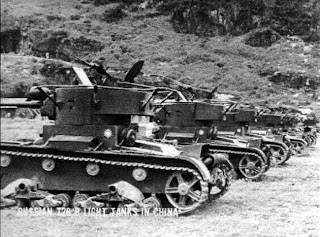
88 (some sources state 87) of these Soviet tanks were supplied between 1938 to 1939. Most were formed into the 1st tank regiment that was assigned to the newly forming 200th Infantry Division, the only motorized infantry formation in the Chinese Army at that time. Weight: 10.5 tons. Armament: One 45 mm gun and one bow mounted MG. Some had a second MG for AA purposes.


Click here for a short history of the T-26 provided by wargaming.net
By 1941, well over 12,000 units of this tank were produced, making it the most numberous vehicle in the Soviet inventory at that time. The Germans destroyed and captured huge numbers of these tanks when they invaded Russia. Many of these were converted into tractors for artillery or self propelled guns. The series ceased entirely in 1941 when the Germans overran most it this tank's manufacturing facilities.

French FT-17
A Number of Renault FTs were acquired by the warlord Chang Tso-Lin in the 1920s and served in his private Manchurian Armay against other warlords. After his assassination by the Japanese, his son permitted the incorsporation of the tanks into Chang Kai-shek’s National Revolutionary Army. Here they are seen in operation around 1929 in northern China.
France had dispatched a small of Renault FT's to Vladivostok in 1919, and these were later passed an to the Manchurian Army under Chang Tso-Ling. The continuing border wars between Bolshevik, White Russian, Chinese and bandit forces led the Soviets to deploy most most of their small inventory of refurbished FTs on the Manchurian border in the mid-1920s. The Manchurian Army purchased 14 more Renaults in 1924-25, and these were used in the fighting with the warlord Wu Pei-fu in 1926. In 1929, the Renaults were nominally attached to the 1st Cavalry Brigade of the Chinese National Revolutionary Army (NRA). During the fighting with the Soviets over the Chinese Eastern Railway in the autumn of 1929 the Soviets brought up a company of MS-1 (T-18) light tanks to counter the Renaults, but a tank-vs-tank confrontation never materialised.
By 1930 the NRA had acquired in various ways about 36 Renault FT-17 tanks and some 24 Carden Loyd machine gun carriers, apart from its armoured train fleet.
The Japanese Army seized nearly all of Chinese/Manchurian Renaults in 1931 when they occupied Manchurian, adding to a small inventory of Renault FTs and NC 27s they had purchased 1922 (? NC 27). In Japanese service, they were known as the Type 79 Ko-Gata. The Renault FTs and NC 27s were used to form two tank companies in 1925 (? NC 27). in 1931, a section of Renaults was sent to Manchuria to operate alongside the Armored Car Platoon of the Kwangtung Army.
In the 1920s, two sections of Renaults were stationed in French Indochina, one in Saigon and the other in the citadel at Hanoi. During the China crises of 1927 the Saigon company was sent to Shanghai to protect the French concessions. It was joined latter in the year by the US Marine Corps Light Tank Platoon, equipped with the Six-Ton Tank. The Marine tanks were used to guard the rail line between Shanghai and Tientsin; and in 1928 two more French FT tank sections arrived to serve in Tientsin. Japan dispatched some of its Renault FTs and NCs to Shanghai in the same role. The Americans departed in 1929, but the French and japanese remained. The Japanese NC 27s, called Type 89 Etsu B, were used during the Shanghai incident of 1931. The Japanese seized the three sections of the French China Light Tank Company in the late 1930s; they were later turned over to the puppet Manchoukuoan Army which used them into the 1940s. The section in Hanoi remained there until 1945, and fought against the Japanese in that year when they occupied the citadel.

